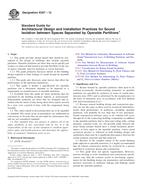Wir benötigen Ihre Einwilligung zur Verwendung der einzelnen Daten, damit Sie unter anderem Informationen zu Ihren Interessen einsehen können. Klicken Sie auf "OK", um Ihre Zustimmung zu erteilen.
ASTM E557-12
Standard Guide for Architectural Design and Installation Practices for Sound Isolation between Spaces Separated by Operable Partitions
Automatische name übersetzung:
Standard-Handbuch für Architectural Design und Installationspraktiken für Schalldämmung zwischen Räumen durch mobile Trennwände getrenntNORM herausgegeben am 1.4.2012
Informationen über die Norm:
Bezeichnung normen: ASTM E557-12
Anmerkung: UNGÜLTIG
Ausgabedatum normen: 1.4.2012
SKU: NS-47197
Zahl der Seiten: 7
Gewicht ca.: 21 g (0.05 Pfund)
Land: Amerikanische technische Norm
Kategorie: Technische Normen ASTM
Kategorie - ähnliche Normen:
Die Annotation des Normtextes ASTM E557-12 :
Keywords:
acoustical, design, installation, movable, operable, partition, sound , Acoustical materials/applications, Installation--acoustic materials, Operable partition, Partitions, ICS Number Code 91.060.10 (Walls. Partitions. Facades)
Ergänzende Informationen
| Significance and Use | ||||||||||
|
Rooms formed by operable partitions often need to be isolated acoustically. Sound-isolating properties of operable partitions are specified by architects in terms of sound transmission class (STC) and so advertised by the manufacturer on the basis of laboratory tests in accordance with Test Method E90 and Classification E413. Because normal building design and construction practices are not the same as those used in acoustical laboratories, actual field performance of partitions, including operable partitions, will probably be less than that of test specimens. Sound transmission between areas to be isolated will occur through all of the connecting building components in addition to the operable partition, that is, floor and ceiling slabs, ceiling plenums, common walls, etc. All possible paths between the areas being isolated should have a sound insulation performance at least equal to the operable partition. Unless good acoustical practice is followed in both building design and installation, there may be a significant discrepancy between the sound isolation expected and that achieved. Because of the complex nature of the sound flanking paths adjacent to operable partitions, it is highly recommended that all related construction details be reviewed by a person qualified in acoustical design and construction. This guide does not specify requirements. However, persons desiring to write installation and construction specifications may find the contents useful in developing requirements for the building design site preparation, and installation practices necessary to minimize leakage and flanking sound around the operable partition. |
||||||||||
| 1. Scope | ||||||||||
|
1.1 This guide provides design details that should be considered in the design of buildings that include operable partitions. Operable partitions are those that can be quickly put in place or removed and stored to provide flexibility in the size of spaces typically used for meetings or social functions. 1.1.1 The guide primarily discusses details in the building design required to limit leakage of sound around an operable partition. 1.1.2 The guide also discusses some factors that affect the performance of the partitions themselves. 1.1.3 This guide is neither a specification for operable partitions nor a document intended to be imposed as a requirement on manufacturers of operable partitions. 1.2 Excluded from this guide are those partitions that are classified by the building products industry as demountable. Demountable partitions are those that are designed and installed with the intent of later being taken down and re-erected by a crew over a period of time, with the components being reusable. 1.3 The values stated in inch-pound units are to be regarded as standard. The values given in parentheses are mathematical conversions to SI units that are provided for information only and are not considered standard. 1.4 This standard does not purport to address all of the safety problems, if any, associated with its use. It is the responsibility of the user of this standard to establish appropriate safety and health practices and determine the applicability of regulatory limitations prior to use. |
||||||||||
| 2. Referenced Documents | ||||||||||
|
Ähnliche Normen:
Historisch
15.7.2014
Historisch
15.7.2013
Historisch
1.12.2011
Historisch
1.6.2014
Historisch
1.1.2014
Historisch
1.2.2009
Empfehlungen:
EEviZak – alle Gesetze einschließlich ihrer Evidenz in einer Stelle
Bereitstellung von aktuellen Informationen über legislative Vorschriften in der Sammlung der Gesetze bis zum Jahr 1945.
Aktualisierung 2x pro Monat!
Brauchen Sie mehr Informationen? Sehen Sie sich diese Seite an.



 ASTM E2707-14
ASTM E2707-14 ASTM E2837-13
ASTM E2837-13 ASTM E2841-11
ASTM E2841-11 ASTM E2925-14
ASTM E2925-14 ASTM E330/E330M-14..
ASTM E330/E330M-14.. ASTM E331-00(2009)..
ASTM E331-00(2009)..
 Cookies
Cookies
